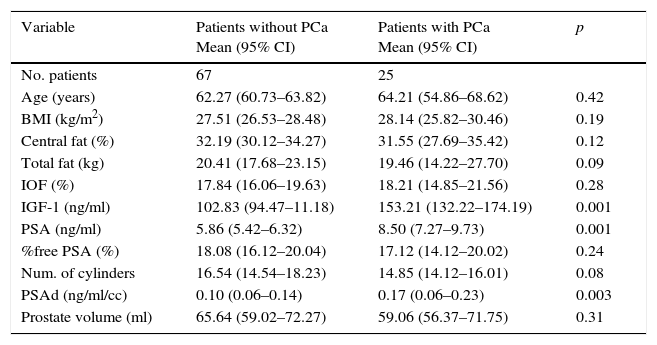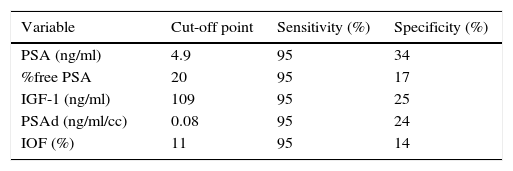To assess the usefulness of IGF-1 and internal organ fat measured by bioelectrical impedance audiometry to avoid rebiopsies in patients with persistently high prostate-specific antigen (PSA) levels.
Material and methodA prospective study was conducted with 92 patients who underwent prostate rebiopsy due to high PSA levels with negative results in the rectal examination and a lack of preneoplastic lesions. The patients previously had their IGF-1 levels measured and had undergone an impedance audiometry test using the abdominal Fat Analyzer AB-140 TANITA system. We calculated the receiver operating characteristic (ROC) curves for the PSA levels, %PSA, internal organ fat and IGF-1 and PSA density.
ResultsTwenty-five patients were diagnosed with prostate cancer. These patients had significantly higher PSA, PSAd and IGF-1 values and a tendency toward higher internal organ fat levels and lower %PSA readings (p=.001, p=0.003, p=0.001, p=0.24 and p=0.28, respectively). The ROC curve showed an area under the curve for IGF-1 and PSA of 0.82 and 0.81, respectively. Using the cutoff points for 95% sensitivity and using the 3 criteria as an indication of rebiopsy, 74% of the biopsies would have been spared, leaving undiagnosed only 1 patient with clinically significant cancer—Gleason score>7 (4+3). The positive and negative predictive values for the set of variables were higher than for each one separately (PPV: 66/NPV: 63). The cost of both determinations was 82 euros.
ConclusionsOur results suggest that measuring IGF-1 could significantly decrease the number of unnecessary rebiopsies in an inexpensive and safe manner.
Valorar la utilidad del IGF-1 y la grasa en órganos internos medida por impedanciometría bioeléctrica para el ahorro de rebiopsias innecesarias en pacientes con persistencia de PSA elevado.
Material y métodoEstudio prospectivo en 92 pacientes sometidos a rebiopsia de próstata por PSA elevado con tacto rectal negativo y ausencia de lesiones preneoplásicas. Previamente se determinó el valor de IGF-1 y se realizó un test de impedanciometría mediante el sistema abdominal Fat Analyser AB-140 TANITA. Se calcularon las curvas ROC para el PSA, % PSA, grasa en órganos internos e IGF-1 y PSA densidad.
ResultadosVeinticinco pacientes fueron diagnosticados de cáncer de próstata. Estos presentaron de forma significativa mayores valores de PSA, PSAd e IGF-1 y una tendencia a mayores valores de grasa en órganos internos y menores cifras de %PSA (p=0,001; p=0,003; p=0,001; p=0,24 y p=0,28 respectivamente). La curva ROC mostró un área bajo la curva del IGF-1 y del PSA de 0,82 y 0,81. Empleando los puntos de corte para la sensibilidad del 95% y usando los 3 criterios como indicación de rebiopsia se habría ahorrado un 74% de las biopsias dejando de diagnosticar únicamente a un paciente con cáncer clínicamente significativo—>Gleason 7 (4+3)—. Los valores predictivos positivo y negativo para el conjunto de las variables fue superior a las de cada una por separado (VPP: 66/VPN: 63). El coste de ambas determinaciones es de 82 euros.
ConclusionesNuestros resultados sugieren que la medición de IGF-1 podría disminuir el número de rebiopsias innecesarias de forma significativa, barata e inocua.












